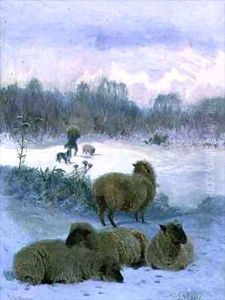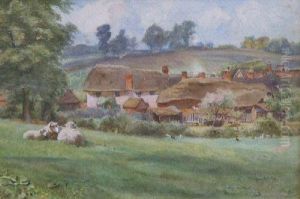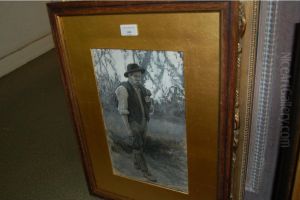Walter Bothams Paintings
Walter Bothams was an English painter, born in 1861, whose work primarily focused on landscapes, rural scenes, and animals, capturing the bucolic life of England during the late 19th and early 20th centuries. Bothams' artistry was rooted in the tradition of Victorian landscape painting, but he often infused his works with a sense of realism and an attention to detail that set him apart from his contemporaries.
Growing up in a period marked by rapid industrialization and social change, Bothams developed a keen interest in the disappearing rural landscapes of England. This nostalgia for a vanishing way of life became a central theme of his work. He studied art at a time when the Royal Academy was the pinnacle of an artist's education in Britain, though specific details about his educational background remain scant. Bothams' technique and style suggest that he received formal training, likely in London, which was the heart of the British art world at the time.
Throughout his career, Bothams exhibited a profound dedication to capturing the essence of the English countryside, its farms, and its villages. His paintings often depicted serene pastoral scenes, farm animals, and country folk, rendered with a remarkable sense of light and atmosphere. This focus on rural themes was somewhat at odds with the contemporary trends of British art, which were moving towards modernism and the avant-garde. However, Bothams' adherence to traditional subjects and techniques earned him a dedicated following, particularly among those who yearned for a representation of England's pastoral heritage.
Bothams' work was exhibited in various venues, including the prestigious Royal Academy, though he never became a member. His paintings are characterized by their detailed brushwork and vibrant colors, qualities that made his depictions of English landscapes particularly appealing. Despite the lack of widespread recognition during his lifetime, Bothams contributed significantly to the preservation of England's rural imagery through his art.
Walter Bothams passed away in 1939, leaving behind a body of work that continues to be appreciated for its beauty and historical value. His paintings are now considered important records of the English countryside during a time of great change, offering insight into the rural life that was an integral part of the nation's identity. Bothams' legacy is that of a skilled landscape painter who cherished and preserved the vistas of a rapidly transforming England.


